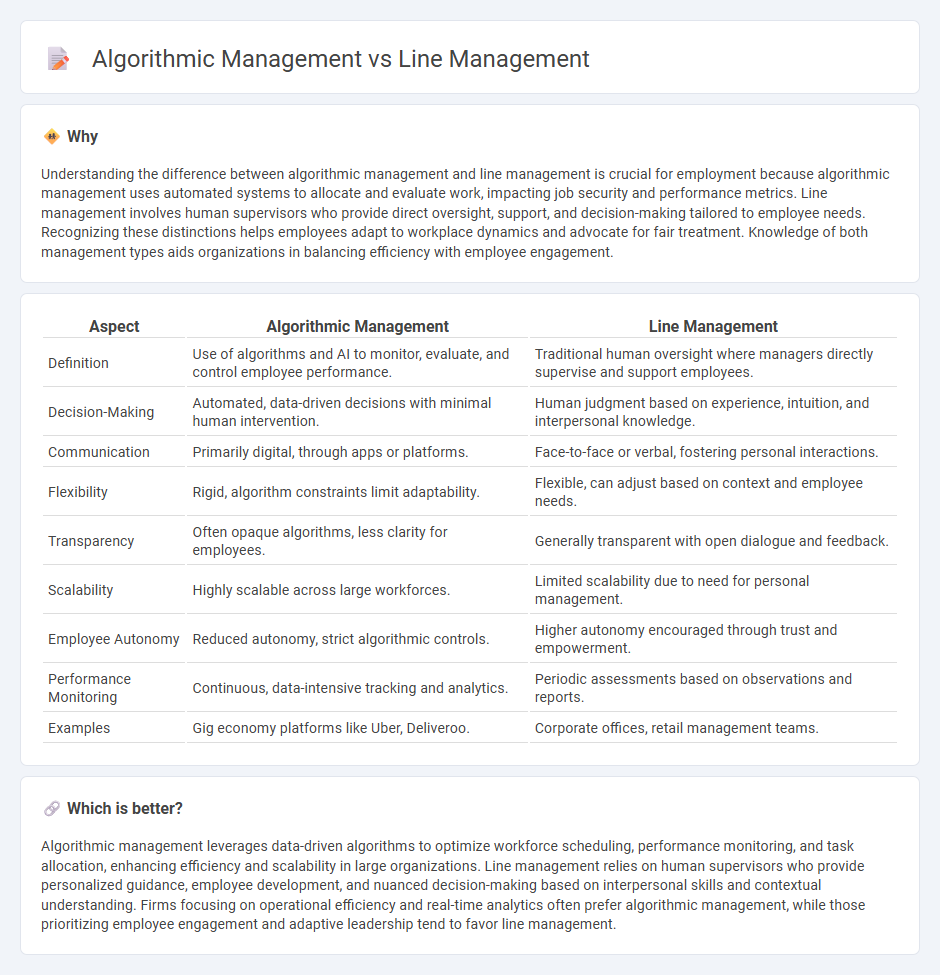
Algorithmic management leverages data-driven algorithms to assign, monitor, and evaluate employee tasks in real time, optimizing workflow efficiency and productivity. Line management relies on direct human supervision and traditional hierarchical structures to guide and assess employee performance. Explore how these distinct approaches transform workplace dynamics and employee experience.
Why it is important
Understanding the difference between algorithmic management and line management is crucial for employment because algorithmic management uses automated systems to allocate and evaluate work, impacting job security and performance metrics. Line management involves human supervisors who provide direct oversight, support, and decision-making tailored to employee needs. Recognizing these distinctions helps employees adapt to workplace dynamics and advocate for fair treatment. Knowledge of both management types aids organizations in balancing efficiency with employee engagement.
Comparison Table
| Aspect | Algorithmic Management | Line Management |
|---|---|---|
| Definition | Use of algorithms and AI to monitor, evaluate, and control employee performance. | Traditional human oversight where managers directly supervise and support employees. |
| Decision-Making | Automated, data-driven decisions with minimal human intervention. | Human judgment based on experience, intuition, and interpersonal knowledge. |
| Communication | Primarily digital, through apps or platforms. | Face-to-face or verbal, fostering personal interactions. |
| Flexibility | Rigid, algorithm constraints limit adaptability. | Flexible, can adjust based on context and employee needs. |
| Transparency | Often opaque algorithms, less clarity for employees. | Generally transparent with open dialogue and feedback. |
| Scalability | Highly scalable across large workforces. | Limited scalability due to need for personal management. |
| Employee Autonomy | Reduced autonomy, strict algorithmic controls. | Higher autonomy encouraged through trust and empowerment. |
| Performance Monitoring | Continuous, data-intensive tracking and analytics. | Periodic assessments based on observations and reports. |
| Examples | Gig economy platforms like Uber, Deliveroo. | Corporate offices, retail management teams. |
Which is better?
Algorithmic management leverages data-driven algorithms to optimize workforce scheduling, performance monitoring, and task allocation, enhancing efficiency and scalability in large organizations. Line management relies on human supervisors who provide personalized guidance, employee development, and nuanced decision-making based on interpersonal skills and contextual understanding. Firms focusing on operational efficiency and real-time analytics often prefer algorithmic management, while those prioritizing employee engagement and adaptive leadership tend to favor line management.
Connection
Algorithmic management enhances line management by providing data-driven insights and real-time monitoring tools that optimize workforce productivity and decision-making. Line managers utilize algorithmic systems to allocate tasks, track performance, and ensure compliance with organizational goals, leading to more efficient resource management. This integration streamlines communication, reduces bias, and accelerates operational processes in employment settings.
Key Terms
Decision-making authority
Line management holds decision-making authority through hierarchical structures, empowering managers to make choices based on experience and organizational goals. Algorithmic management, driven by data analytics and AI, delegates decisions to automated systems optimizing efficiency and real-time responsiveness. Explore the nuances of decision-making authority in both models to understand their impact on organizational control and agility.
Human supervision
Line management emphasizes direct human supervision through face-to-face interactions, personalized feedback, and relational leadership to guide employee performance and development. Algorithmic management deploys data-driven systems and AI to monitor, evaluate, and assign tasks automatically, often reducing human discretion and increasing efficiency but potentially impacting worker autonomy. Explore the evolving balance between human and algorithmic oversight in organizational management practices for deeper insights.
Automated oversight
Line management relies on human supervisors to monitor employee performance and provide feedback, while algorithmic management employs automated systems and data-driven algorithms to oversee tasks, productivity, and compliance in real time. Automated oversight enhances efficiency by reducing bias, increasing consistency, and enabling scalable supervision across large workforces, particularly in gig economy and remote work environments. Explore the nuances and implications of automated oversight in workforce management to understand its impact on modern organizational structures.
Source and External Links
Line management - Wikipedia - Line management is the function of managing employees directly involved in production or service delivery, with line managers overseeing day-to-day operations, implementing policies, and ensuring departmental goals and organizational objectives are met.
Who are Line Managers? What is Their Role in Employee Management? - Line managers serve as the key contact between management and staff, responsible for implementing company strategies, managing employee performance, resolving workplace issues, and motivating teams to fulfill business goals.
What is a Line Manager? - Line managers guide teams to meet company objectives while supporting individual employee development through coaching, setting measurable targets, and maintaining communication between leadership and frontline workers.
 dowidth.com
dowidth.com